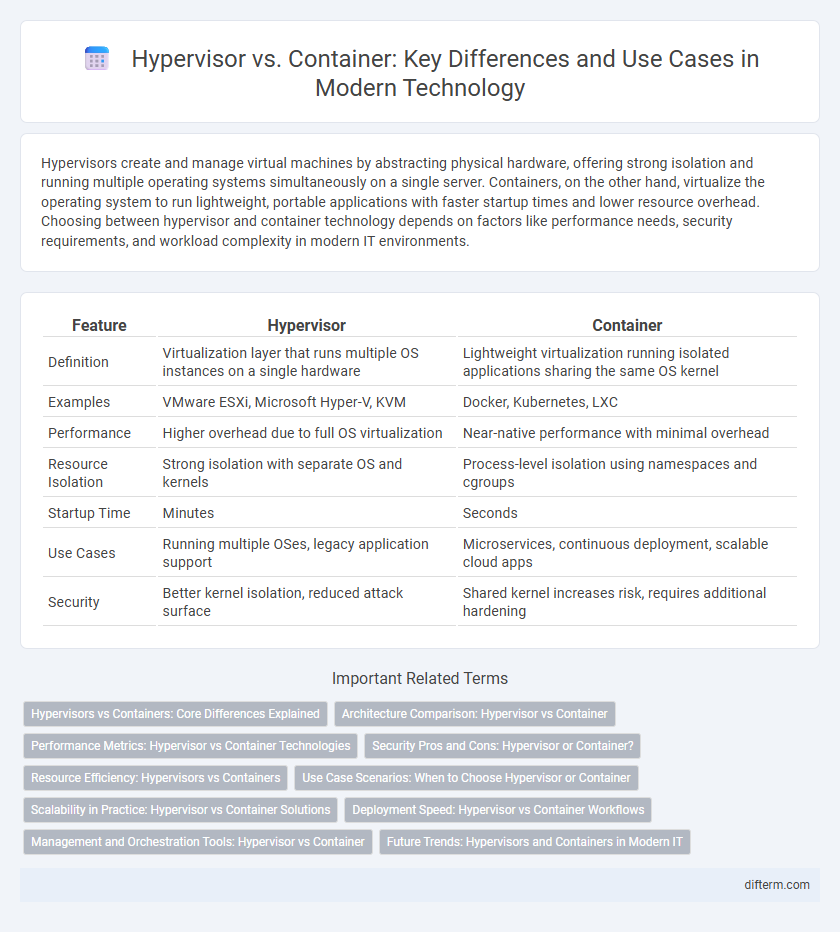Hypervisors create and manage virtual machines by abstracting physical hardware, offering strong isolation and running multiple operating systems simultaneously on a single server. Containers, on the other hand, virtualize the operating system to run lightweight, portable applications with faster startup times and lower resource overhead. Choosing between hypervisor and container technology depends on factors like performance needs, security requirements, and workload complexity in modern IT environments.
Table of Comparison
| Feature | Hypervisor | Container |
|---|---|---|
| Definition | Virtualization layer that runs multiple OS instances on a single hardware | Lightweight virtualization running isolated applications sharing the same OS kernel |
| Examples | VMware ESXi, Microsoft Hyper-V, KVM | Docker, Kubernetes, LXC |
| Performance | Higher overhead due to full OS virtualization | Near-native performance with minimal overhead |
| Resource Isolation | Strong isolation with separate OS and kernels | Process-level isolation using namespaces and cgroups |
| Startup Time | Minutes | Seconds |
| Use Cases | Running multiple OSes, legacy application support | Microservices, continuous deployment, scalable cloud apps |
| Security | Better kernel isolation, reduced attack surface | Shared kernel increases risk, requires additional hardening |
Hypervisors vs Containers: Core Differences Explained
Hypervisors create and manage multiple virtual machines (VMs) each with its own operating system, providing strong isolation and resource allocation at the hardware level. Containers, by contrast, run applications in isolated user spaces within a single OS kernel, enabling lightweight, faster deployment with shared system resources. Core differences include hypervisors' hardware-level virtualization versus containers' operating system-level virtualization, impacting performance, scalability, and use cases in cloud computing and application development.
Architecture Comparison: Hypervisor vs Container
Hypervisors create and manage multiple virtual machines by abstracting hardware resources at the host level, enabling complete OS isolation with dedicated kernels for each VM. Containers share the host OS kernel and isolate applications at the process level, providing lightweight and efficient virtualization with faster startup times. This architectural difference impacts resource allocation, security boundaries, and performance, where hypervisors offer stronger isolation but higher overhead compared to containers.
Performance Metrics: Hypervisor vs Container Technologies
Hypervisors typically introduce higher overhead due to hardware virtualization, impacting CPU and memory performance, whereas containers leverage OS-level virtualization, resulting in near-native performance with faster startup times and more efficient resource utilization. Benchmark tests show containers often achieve lower latency and higher throughput compared to hypervisor-based virtual machines, especially in I/O operations and network performance. Resource isolation differences also affect scalability, with containers enabling greater density on a single host, which is crucial for environments demanding rapid deployment and high performance.
Security Pros and Cons: Hypervisor or Container?
Hypervisors provide robust isolation by running multiple virtual machines with separate kernels, minimizing security risks from cross-VM attacks. Containers share the host OS kernel, which can lead to increased vulnerability due to weaker isolation but offer faster deployment and lower overhead. Choosing hypervisor-based virtualization supports stronger security boundaries at the cost of performance, while containerization prioritizes efficiency with potentially higher exposure to kernel-level exploits.
Resource Efficiency: Hypervisors vs Containers
Containers demonstrate superior resource efficiency by sharing the host operating system kernel, allowing multiple isolated applications to run without the overhead of separate guest OS instances required by hypervisors. Hypervisors allocate dedicated resources to each virtual machine (VM), resulting in higher memory and CPU consumption compared to containers. This streamlined resource utilization makes containers ideal for environments requiring rapid scaling and optimized performance.
Use Case Scenarios: When to Choose Hypervisor or Container
Hypervisors are ideal for running multiple diverse operating systems on a single physical server, making them suitable for legacy application support, complete OS isolation, and environments requiring strong security boundaries. Containers excel in microservices architecture, continuous integration/continuous deployment (CI/CD) pipelines, and scenarios demanding rapid scalability with minimal overhead due to their lightweight nature and shared OS kernel. Choosing hypervisors is best for resource-heavy virtualization needs, while containers are preferred for application portability and efficient resource utilization in cloud-native developments.
Scalability in Practice: Hypervisor vs Container Solutions
Hypervisors provide strong isolation by running multiple virtual machines on a single physical host, but they often require more system resources, limiting scalability in large-scale deployments. Containers leverage lightweight virtualization at the OS level, enabling rapid scaling by sharing the host kernel and consuming fewer resources, making them ideal for dynamic microservices architectures. Practical scalability with containers allows for quick orchestration and management using tools like Kubernetes, surpassing traditional hypervisor-based solutions in agility and resource efficiency.
Deployment Speed: Hypervisor vs Container Workflows
Containers offer significantly faster deployment speeds compared to hypervisors due to their lightweight architecture that shares the host OS kernel, eliminating the need to boot a full operating system. Hypervisors, which create and manage virtual machines with isolated OS instances, typically require more resources and longer startup times. This efficiency makes containers ideal for rapid scaling and continuous integration/continuous deployment (CI/CD) pipelines in modern application workflows.
Management and Orchestration Tools: Hypervisor vs Container
Management and orchestration tools for hypervisors such as VMware vSphere and Microsoft System Center provide robust VM lifecycle control, resource allocation, and security policies within virtualized environments. Container orchestration platforms like Kubernetes and Docker Swarm enable scalable deployment, automated scaling, and self-healing for containerized applications across distributed clusters. These tools optimize infrastructure utilization and operational efficiency, with hypervisor management focusing on full OS instances while container orchestration emphasizes lightweight, portable application workloads.
Future Trends: Hypervisors and Containers in Modern IT
Future trends in modern IT highlight a convergence where hypervisors and containers complement each other to enhance virtualization efficiency and scalability. Hypervisors continue evolving with improved security and support for heterogeneous environments, while containers gain momentum through lightweight orchestration and seamless cloud integration. The integration of AI-driven management and edge computing accelerates the adoption of hybrid models combining hypervisors and containers for optimized resource utilization.
Hypervisor vs Container Infographic

 difterm.com
difterm.com